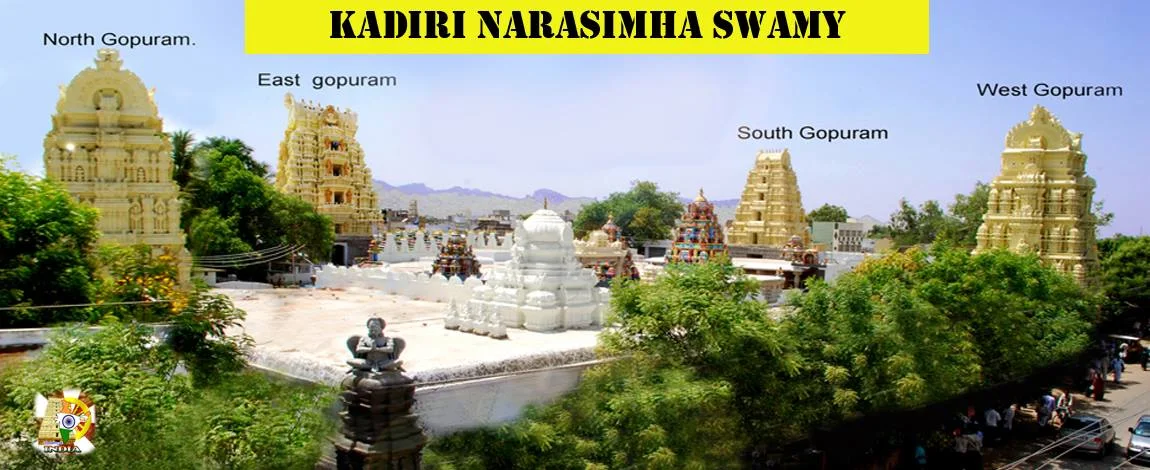KHADRI STHALAPURANAM - Kadiri Temple
The Temple of Sri Lakshmi Narasimha Swamy is one among the many renowned shrines in the Rayala Seema are ranking the importance with the great shrine of Sri Venkateswara Swamy, at Tirupati. The local hill called stotradri is the place where the devas worshipped the Lord after He destroyed the demon Hinranyakasipu in the Durgam in Godduvelagala vge which is situated nearby to this town Kadiri.
Some derivative meanings are attributed to the word Khadri denoting the place with a hill representing the feet of Vishnu. Another version is that the town has been named after the Khadri tree (Acacia catchedu) under which the idol of the local temple of Narasiha Swamy is found. The place of kadri and its surroundings are connected with several pouranic legends. It is said that the sage Vedavyasa without being known to asuras imparted lessons to his disciples and so the place is called Kedaranyam. The tradition is that the present town was formerly a jungle under the poligar of Patnam and that the town is coeva, with the temple which was named after the tree under which the idol was found in an ant hill. The jungle was cleared by the poligar and the temple was built on the site. It is also said to be that the Mulavarlu in this temple was in wood like Puri Jagannadh in Orissa state and was housed on the branch of Chandra Tree. It is also said to be that the mulavarlu is Swayabhu.
The image of Sri Narasimha Swamy is in human form with a Lion’s Head, covered with silver armour decorated with silver shoulder blades, moustaches, and eyes, and is in the posture of bearing the stomach of Hiranyakasipu. The procession image of the deity is in the form of Vishnu made of metal with Bhudevi and Sridevi on either side. Actually, the kings from the Paschima Chalakya Dynasty housed Durgadevi under an amazing stone curved pillar mandapam, and Lakshmi Devi Vigraham was also housed in the temple in 1953. As per the orders of the Lord Narasimha Swamy varu the Lord Idol was housed and mandapams equal to Ammavari temple are constructed in excellent curving on stones to southern side to ammavari Temple was constructed by the Vijaya Nagara Rulers.
As per the mythology that the uthsava murthies were handed down to Bhrigu Rishi by the Lord himself in a petika or box for his daily worship. The Lord is further worshipped in the names of Vasantha Vallabhudu or Vasantha Madhavulu as the pratista was done in the Spring season. The river Maddileru, other wise called as the Arjuna River, (where Arjun did penace) has its pounranic fame as being the river on the banks of which Arjuna did penance. The course of the river is through 6 theerthams called respectively:1.Swetapushkarini 2. Bhrugu Theertham 3.Sesha Theertham, 4. Kunti Theertham 5. Laxmin Theertham,6.Ganga Theertham 7. Garuda Theertham and 8. Bhavanasi Theertham.
The temple is enclosed in a 500 ft square high walled compound with 4 entrances having a gopuram at each entrance constructed. The stone sculpture in Yagnamantapam conspicuously abound in lions. The temple is facing east and the Kalyanamandapam in its front to the left Yagasala a pakasala, astana mandapam to the north where the utsava vigraha of the lord is made to sit during the festival are the important structures within the compound. A 80 ft square pushkarini is in the north east corner within the temple compound. To the south of the temple there is the shrine of Chinnamma with her image in stone.
 |
| Kadri Sri Lakshmi Narasimha Swamy |
The inscriptions in the temple relate mostly to the Vijayanagar period and are all in Telugu, except two. One of them on the south wall of the Arthamantapuram, states that the temple was built by a Nayaka during the reign of Bukka I saka 1274 (1332 A.D.). Another inscription near it, dated the next year records the gift of a jewel to the idol by Gopanna an officer under Kempanna Odeyar, the restorer of the Srirangam temple and the contemporary of Vedanta Desikar. A stone slab is said to contain an inscription regarding this custom which still prevails. Yet another inscription shows that in the Salivahana Saka 1451, 1529 A.D. the paralegal of Tadipatri constructed the Vasanta mandapam adjacent to the prakaram (now called the thousand pillar mandapam in which feeding is conducted along with breathtaking Kotai Mandapam. Further proof of the antiquity of the temple, its greatness and importance, and the sanctity attached to it, are vividly described in the Khadri Sthalapuranam in Brahmanda Puranam. The temple car which is considered to be the biggest in Weight in South India contains numerous indecent carvings and the Car streets contain several small mantapams on four tall pillars in which the idol is set down and worshipped during festivals.
The famous East, South, North, and West Rajagopurams of this temple were constructed by Vijayanagara Emperors, Chinnamma a devotee, not known, Kokanti Poligar respectively. The gateway at West Rajagopuram, leads to a tank that supplies water to the temple from which principal metal idols of the temple were recovered by the Sage Brigu. The popular king of Vijaya Nagara Sri Krishna Devaraya and Maharastra King Shivaji Maharaj visited this famous temple and constructed sub-temples and Mahishasuramardini Temple respectively.











